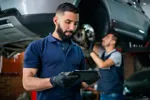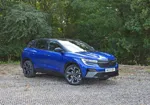By Rupert Armitage, managing director, Auto Windscreens
This week Mercedes-Benz USA released a statement saying that it “strongly recommends” using only Mercedes-Benz parts for windshield glass replacements.
In the same statement, Mercedes-Benz noted that the windshield glass manufactured for its vehicles has very particular specifications and that manufacturers of non OEM glass would not have access to the same technology that can ensure one hundred percent compatibility with Mercedes-Benz vehicle systems.
The glass for the latest Mercedes-Benz models contains solar glass technology which is coated with a thin transparent liquid that provides the passengers with protection against harmful ultraviolet rays from the sun and helps reduce the heat levels in the Mercedes-Benz vehicle. This also allows optimised fuel consumption and improvement of the performance of the car’s air conditioning.
I’ve seen numerous ADAS related conversations on LinkedIn over the past couple of weeks about use of non OEM glass and recalibration. Some debates were deliberately instigated by me and most come back to the same point – customers are being told misleading and frankly, dangerous information when it comes to this aspect of glass replacement. The posts have had thousands of views and many comments from industry peers with differing opinions on the best solution.
I enjoy a debate and have no issue with people expressing differing opinions to my own. What I do object to is peddling lies to protect what I would currently describe as the ‘Emperor’s New Clothes’ of the windscreen repair industry.
An acquaintance shared his experience trying to get his windscreen recalibrated correctly. He was told by one particular rival that “some dealers use cardboard and stepladders for recalibration” in a bid to get him to accept their preferred method, using the aftermarket. He was also told that non-OEM glass was “the same without the sticker”.
He was, like me, informed and could therefore make a considered choice on his repair – preferring to get it done using genuine glass in the dealership. However, the majority of people don’t understand the complicated workings of their vehicle.
They don’t understand that their safety systems are reliant on specific technology and need carefully controlled ADAS recalibration following a windscreen replacement.
Technology is constantly changing and keeping up with the latest developments is challenging for everyone. The difference here is that we’re talking about the safety of a vehicle – the maintenance of the integrity of its systems. Customers are reliant on us to know what we’re doing and returning the vehicle to them functioning exactly as it did when it left the dealership.
For me the most alarming post was from Volvo Body & Paint Development Manager, Steve Plunkett, who overheard a well-known ADAS conference attendee saying, "well nobody has been killed yet".
This is a disgraceful demonstration of what I have found to be true in the last couple of years when it comes to ADAS – there are some people waiting for a serious incident to occur before they will act. Protecting past commercial investments in the aftermarket appears to be taking precedence over safety. There is misleading information about what can be achieved by bodyshops who are lured in by additional revenue and false promises of recalibrating 100% of vehicles.
We’re all discussing our opinions on LinkedIn but when are we going to work together to make sure that our customers are safe?
This Road Safety Week we should all be focussing on what needs to be done to regulate this cowboy aspect of repair befpore someone dies.
I write this with the intention of opening the gauntlet and stoking debate. What is safe and what is skirting the boundaries of what is acceptable? It’s time we stopped sitting on the fence.
This Road Safety Week put your customers first. We have a duty of care and an opportunity to act before someone is killed. Let’s not waste it.
















Login to comment
Comments
No comments have been made yet.